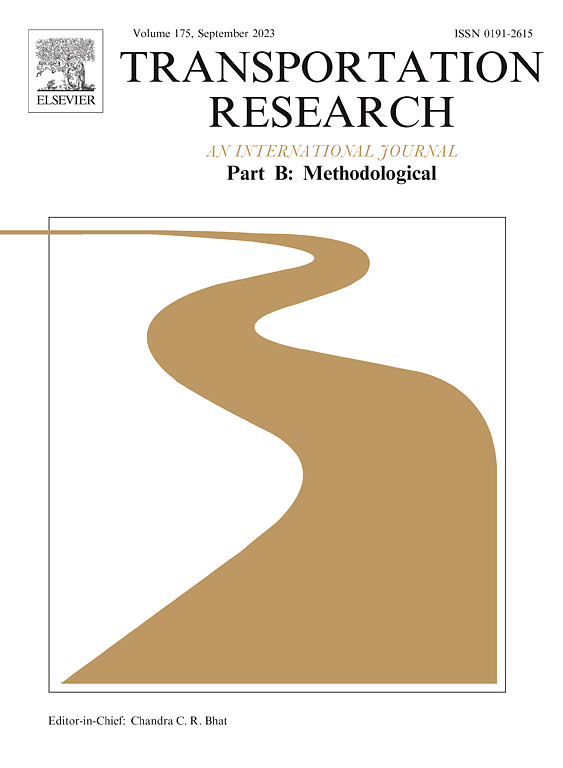Dynamic electric vehicle fleets management problem for multi-service platforms with integrated ride-hailing, on-time delivery, and vehicle-to-grid services
IF 6.3
1区 工程技术
Q1 ECONOMICS
引用次数: 0
Abstract
The rapid adoption of electric vehicles (EVs) and the surge in mobility service demand necessitate efficient management of EV fleets. In practice, these vehicles often remain idle for extended periods due to fluctuating demand, leading to underutilized resources and lost revenue. In response, this paper investigates a dynamic multi-service platform that concurrently coordinates ride-hailing, on-time delivery, and vehicle-to-grid (V2G) energy services. By leveraging synergies across these services, the proposed coordination strategy improves resource utilization, reduces operational costs, and increases profitability. Upon accessing the platform, users submit various service requests that specify the origin, destination, time windows, and either the number of riders or the weight of goods. To meet these heterogeneous, real-time demands, we propose a dynamic multi-service electric vehicle fleet management (MEFM) problem to optimize the allocation, routing, and scheduling of EV fleets to maximize platform profits over each time period. We formulate the proposed MEFM problem as an arc-based mixed-integer linear programming (MILP) model and develop a customized branch-and-price-and-cut (B&P&C) algorithm for its efficient solution. Our algorithm integrates Dantzig–Wolfe decomposition, improved with subset row cuts, and a novel labeling sub-algorithm that effectively captures multi-service coordination, fleet capacity, and battery-level constraints under partial recharging flexibility. Extensive numerical experiments based on a case study in the context of Shenzhen, China, demonstrate that the customized B&P&C algorithm achieves computation speeds on average 150.99 times faster than the state-of-the-art commercial solver (Gurobi), with speed-ups ranging from 3.33 to 477.42 times, while consistently obtaining optimal solutions for large-scale instances where Gurobi fails. Moreover, our results highlight the benefits of integrating on-time delivery and V2G energy services, e.g., despite a modest increase in operational costs, the substantial rise in profits validates the economic potential of the multi-service platforms. We also identify that partial recharging flexibility for EVs further reduces delay costs by up to 70.27% and boosts overall profits by up to 40.90%.
基于网约车、准时交付和车对网一体化多服务平台的动态电动汽车车队管理问题
随着电动汽车的迅速普及和出行服务需求的激增,需要对电动汽车车队进行有效的管理。实际上,由于需求波动,这些车辆往往长时间处于闲置状态,导致资源利用不足和收入损失。为此,本文研究了一个动态的多服务平台,该平台同时协调网约车、准时送货和车辆到电网(V2G)能源服务。通过利用这些服务之间的协同作用,建议的协调策略提高了资源利用率,降低了运营成本,并提高了盈利能力。在进入平台后,用户提交各种服务请求,指定出发地、目的地、时间窗口,以及乘客数量或货物重量。为了满足这些异构的、实时的需求,我们提出了一个动态的多服务电动汽车车队管理(MEFM)问题,以优化电动汽车车队的分配、路线和调度,以最大化平台在每个时间段的利润。我们将所提出的MEFM问题表述为基于弧的混合整数线性规划(MILP)模型,并开发了一种定制的分支-价格-削减(B&P&;C)算法来有效解决该问题。我们的算法集成了dantzigg - wolfe分解,改进了子集行切割,以及一种新的标记子算法,该算法有效地捕获了部分充电灵活性下的多服务协调、车队容量和电池水平约束。基于中国深圳的案例研究的大量数值实验表明,定制的B&;P&;C算法的计算速度平均比最先进的商业求解器(Gurobi)快150.99倍,加速范围从3.33到477.42倍,同时在Gurobi失败的大规模实例中始终获得最优解。此外,我们的研究结果强调了整合准时交付和V2G能源服务的好处,例如,尽管运营成本略有增加,但利润的大幅增长验证了多服务平台的经济潜力。我们还发现,电动汽车的部分充电灵活性进一步降低了高达70.27%的延迟成本,并提高了高达40.90%的总利润。
本文章由计算机程序翻译,如有差异,请以英文原文为准。
求助全文
约1分钟内获得全文
求助全文
来源期刊
CiteScore
12.40
自引率
8.80%
发文量
143
审稿时长
14.1 weeks
期刊介绍:
Transportation Research: Part B publishes papers on all methodological aspects of the subject, particularly those that require mathematical analysis. The general theme of the journal is the development and solution of problems that are adequately motivated to deal with important aspects of the design and/or analysis of transportation systems. Areas covered include: traffic flow; design and analysis of transportation networks; control and scheduling; optimization; queuing theory; logistics; supply chains; development and application of statistical, econometric and mathematical models to address transportation problems; cost models; pricing and/or investment; traveler or shipper behavior; cost-benefit methodologies.

 求助内容:
求助内容: 应助结果提醒方式:
应助结果提醒方式:


